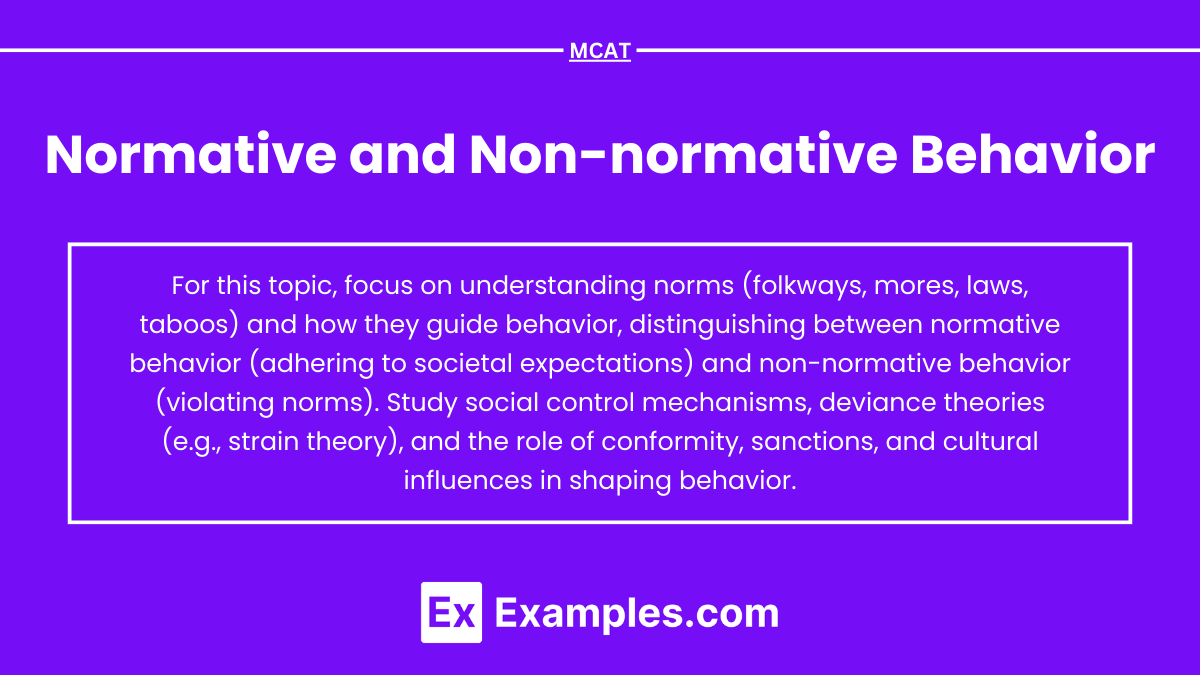Normative behavior aligns with societal norms, values, and expectations, ensuring social harmony by guiding appropriate conduct. It includes conformity, compliance, and adherence to rules or customs such as folkways, mores, and laws. In contrast, non-normative behavior deviates from these standards, often resulting in social stigma or sanctions. Deviance can range from minor violations, like occasional speeding, to more severe forms that shape identity, such as habitual criminal behavior. Understanding these concepts is essential for the MCAT, highlighting how individuals respond to social expectations and consequences.
Learning Objectives
In studying “Normative and Non-Normative Behavior” for the MCAT, you should learn to differentiate between behaviors that conform to societal norms and those that deviate from them. Understand key concepts like folkways, mores, laws, and taboos, along with the impact of conformity, compliance, and obedience on behavior. Evaluate theories of deviance, such as labeling theory, strain theory, and differential association. Explore how socialization shapes behavior and analyze the consequences of non-normative actions, such as social stigma and groupthink. Apply your understanding to interpret behavioral scenarios and predict outcomes in MCAT practice passages related to societal expectations and group dynamics.
Overview of Normative and Non-Normative Behavior
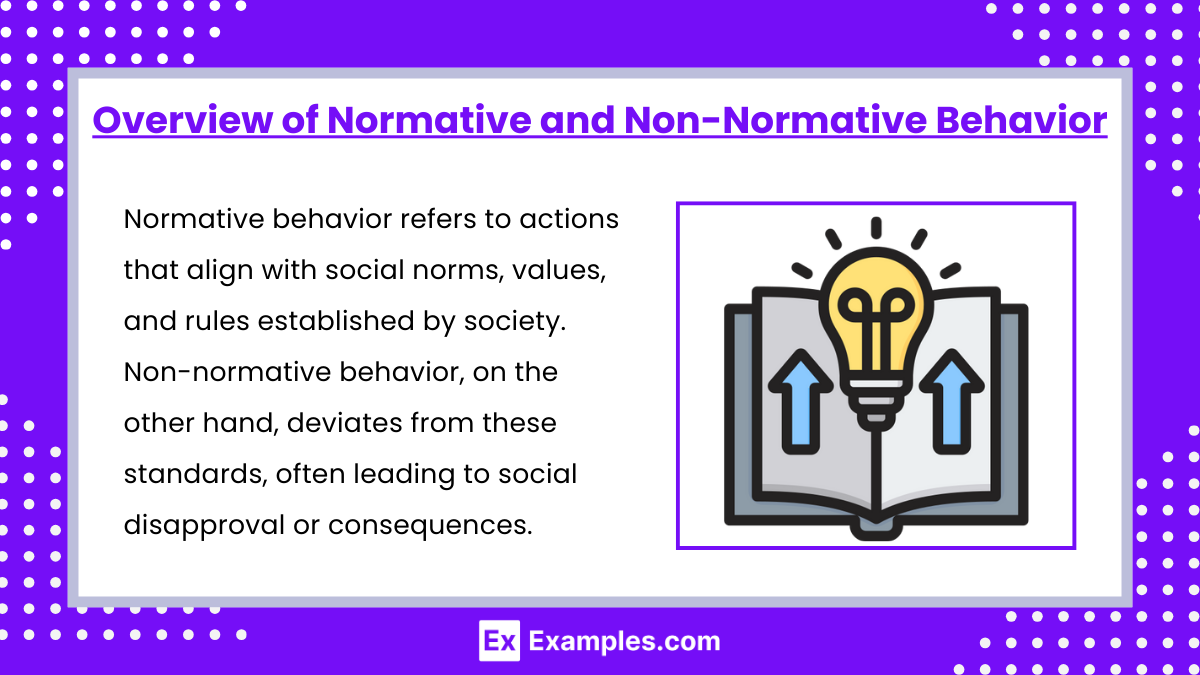
Normative behavior refers to actions that align with social norms, values, and rules established by society. Non-normative behavior, on the other hand, deviates from these standards, often leading to social disapproval or consequences. Understanding these concepts is essential for the MCAT as they help explain how individuals conform to or rebel against societal expectations and the consequences thereof.
Normative Behavior: Adherence to Social Norms
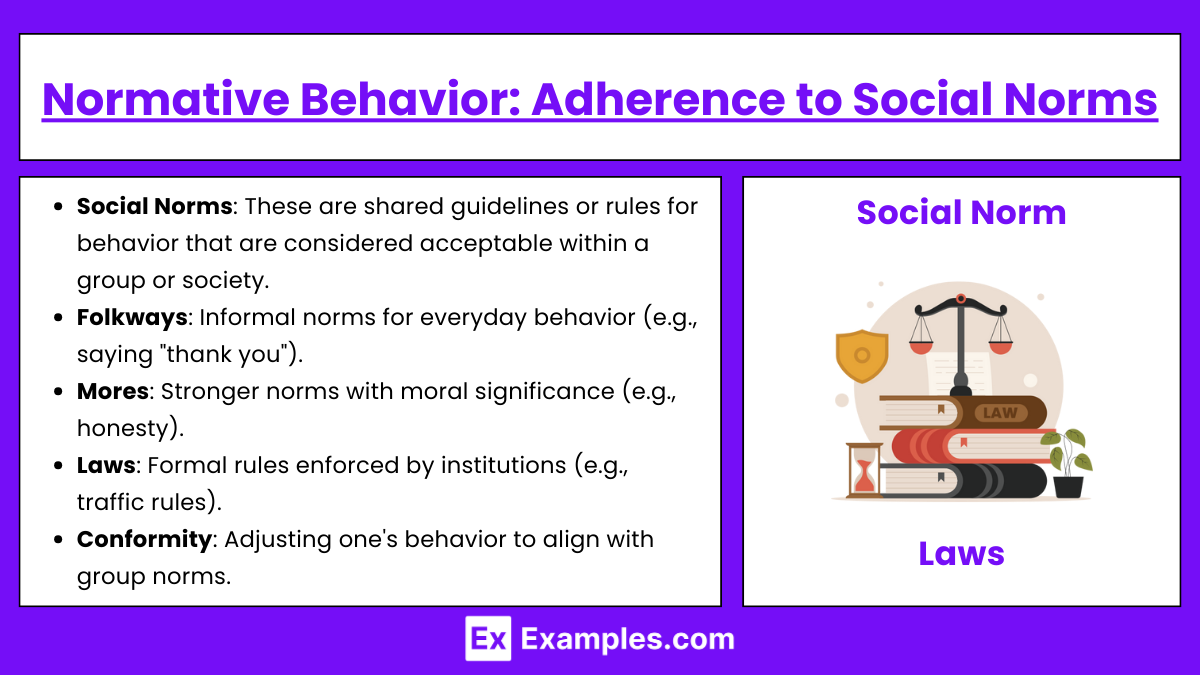
- Social Norms: These are shared guidelines or rules for behavior that are considered acceptable within a group or society.
- Folkways: Informal norms for everyday behavior (e.g., saying “thank you”).
- Mores: Stronger norms with moral significance (e.g., honesty).
- Laws: Formal rules enforced by institutions (e.g., traffic rules).
- Conformity: Adjusting one’s behavior to align with group norms.
- Example: Dressing formally for a business meeting.
- Compliance vs. Obedience:
- Compliance: Changing behavior due to a direct request.
- Obedience: Following orders from an authority figure, even without personal agreement.
Non-Normative Behavior: Deviations from Norms
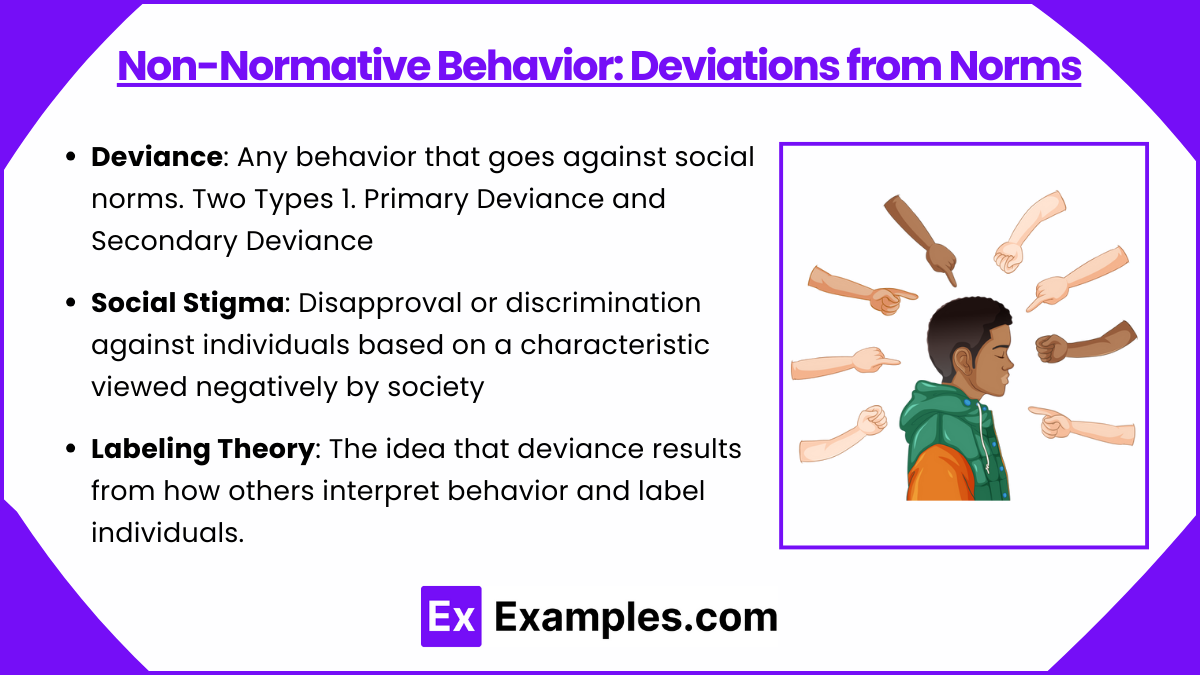
Non-normative behavior violates the accepted standards and may result in sanctions or social stigma.
- Deviance: Any behavior that goes against social norms.
- Primary Deviance: A small violation with little impact on the person’s identity (e.g., occasional speeding).
- Secondary Deviance: Repeated violations that shape an individual’s identity as a deviant (e.g., habitual theft).
- Social Stigma: Disapproval or discrimination against individuals based on a characteristic or behavior viewed negatively by society (e.g., mental illness stigma).
- Labeling Theory: The idea that deviance results from how others interpret behavior and label individuals.
- Example: If a person is labeled as a criminal, they may begin to act according to that label.
Theories of Deviance
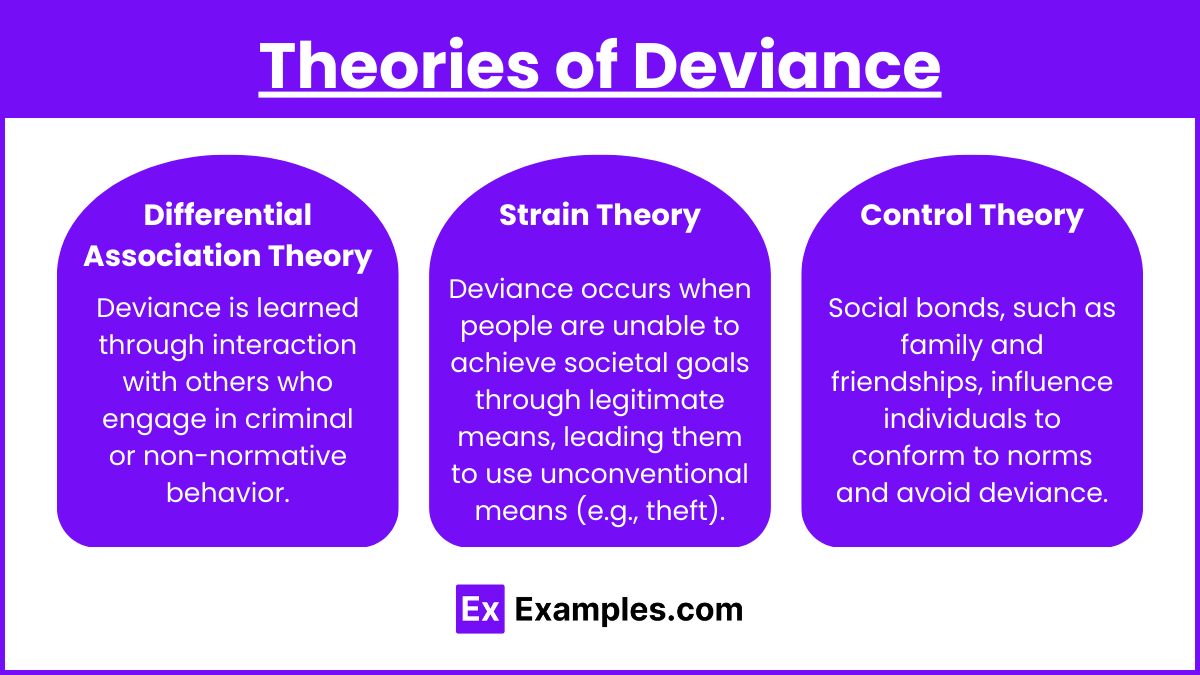
- Differential Association Theory: Deviance is learned through interaction with others who engage in criminal or non-normative behavior.
- Strain Theory: Deviance occurs when people are unable to achieve societal goals through legitimate means, leading them to use unconventional means (e.g., theft).
- Control Theory: Social bonds, such as family and friendships, influence individuals to conform to norms and avoid deviance.
Key Psychological Processes Involving Normative and Non-Normative Behavior
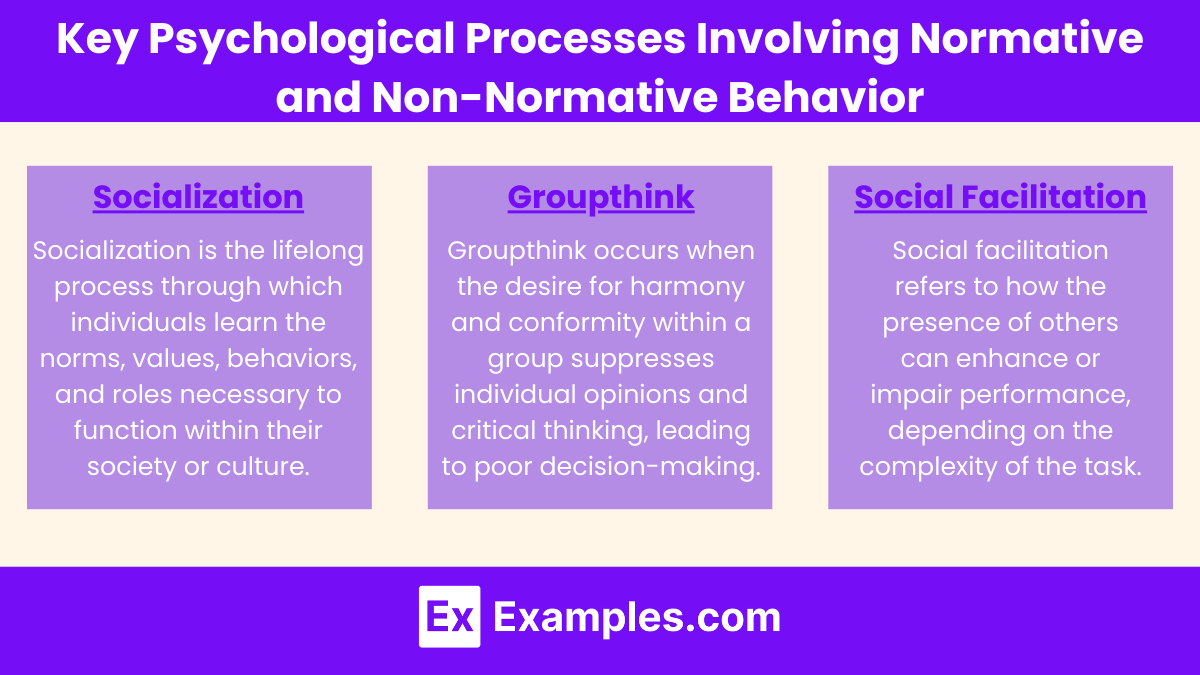
- Socialization: The process by which individuals learn norms, values, and behaviors of their culture. Socialization is the lifelong process through which individuals learn the norms, values, behaviors, and roles necessary to function within their society or culture. It shapes a person’s identity, behavior, and worldview, preparing them to participate in social institutions.
- Groupthink: A situation where the desire for group cohesion leads to poor decision-making, as individuals avoid dissent to conform. Groupthink occurs when the desire for harmony and conformity within a group suppresses individual opinions and critical thinking, leading to poor decision-making. It often emerges in cohesive groups where dissent is discouraged to maintain unity.
- Social Facilitation: The tendency to perform better on simple tasks when in the presence of others, but worse on complex tasks. Social facilitation refers to how the presence of others can enhance or impair performance, depending on the complexity of the task.
Examples
Example 1: Normative Behavior: Wearing Professional Attire to a Job Interview
This behavior aligns with societal expectations that individuals dress formally for job interviews to present themselves professionally. Employers often interpret appropriate attire as a sign of respect and seriousness, which conforms to workplace norms. Dressing according to these expectations increases the chances of a positive outcome, illustrating how individuals follow societal norms to achieve desired results.
Example 2 : Non-Normative Behavior: Interrupting a Formal Meeting to Answer a Personal Phone Call
Social norms discourage personal interruptions during professional meetings, as they indicate disrespect for others’ time. This non-normative behavior can result in negative consequences, such as being reprimanded or damaging one’s professional reputation. It highlights how deviation from established workplace norms can lead to social disapproval or disciplinary actions.
Example 3 : Normative Behavior: Following Traffic Signals
Adhering to traffic signals ensures safety and smooth functioning on the road, reflecting compliance with societal laws. Stopping at a red light is expected and respected, demonstrating how individuals conform to formal rules to maintain order and avoid fines. This behavior represents societal adherence to norms that prioritize safety and efficiency.
Example 4: Non-Normative Behavior: Skipping a Line in a Crowded Store
Social norms expect individuals to wait in line to maintain fairness. Skipping the line violates this expectation and often results in disapproval from others. This behavior, though non-normative, can provoke conflict and may lead to social sanctions, such as verbal confrontations or exclusion from the group.
Example 5 : Normative Behavior: Expressing Gratitude When Receiving Help
Saying “thank you” when someone offers assistance reflects adherence to polite social conventions and is expected in most cultures. This normative behavior strengthens social bonds by showing appreciation, promoting positive interpersonal relationships, and conforming to the norm of politeness. It illustrates how social norms guide everyday interactions to create harmony within society.
Practice Questions
Question 1
Which of the following is an example of non-normative behavior in a competitive market setting?
A. A firm setting prices based on marginal cost.
B. Consumers following the law of demand and purchasing less when prices rise.
C. A firm engaging in price-fixing with competitors to manipulate the market.
D. An entrepreneur starting a new business to meet market demand.
Correct Answer: C.
Explanation:
- Option C is correct because price-fixing is considered a non-normative behavior in microeconomics. It violates competitive market norms and legal frameworks, leading to market inefficiency and harming consumer welfare. Non-normative behavior often involves unethical or illegal practices that disrupt market equilibrium.
- Option A describes normative behavior, where firms set prices efficiently, aligning with economic norms.
- Option B reflects adherence to the law of demand, which is a fundamental normative behavior in microeconomics.
- Option D aligns with normative entrepreneurial behavior, contributing to efficient resource allocation.
Question 2
Which of the following best illustrates normative behavior in consumer decision-making?
A. A consumer hoarding goods during a supply shortage, ignoring market signals.
B. A consumer reducing consumption when their budget constraint tightens.
C. A firm lowering product quality to save on production costs, deceiving customers.
D. A supplier colluding with others to raise prices and reduce competition.
Correct Answer: B.
Explanation:
- Option B is correct because it aligns with the normative behavior of consumers responding logically to budget constraints, which follows economic principles of utility maximization. When prices or budget limits change, consumers adjust their consumption accordingly.
- Option A is non-normative since hoarding disrupts market operations and causes inefficiencies.
- Option C reflects non-normative, unethical behavior that violates consumer trust and market norms.
- Option D is an example of non-normative behavior, as collusion harms competitive market outcomes.
Question 3
In a perfectly competitive market, which of the following behaviors would be considered non-normative and lead to inefficiency?
A. A firm setting prices equal to marginal cost.
B. A monopolist restricting output to increase prices.
C. A producer increasing output in response to rising demand.
D. Consumers maximizing utility given their budget constraints.
Correct Answer: B.
Explanation:
- Option B is correct because a monopolist restricting output is an example of non-normative behavior that causes market inefficiency by creating artificial scarcity and increasing prices. This behavior deviates from the competitive norm where firms produce at efficient levels.
- Option A is normative since firms in perfect competition typically set prices at marginal cost to maximize efficiency.
- Option C aligns with normative behavior, reflecting how producers respond efficiently to demand changes.
- Option D is normative consumer behavior, ensuring efficient allocation of resources by maximizing utility within budget constraints.

